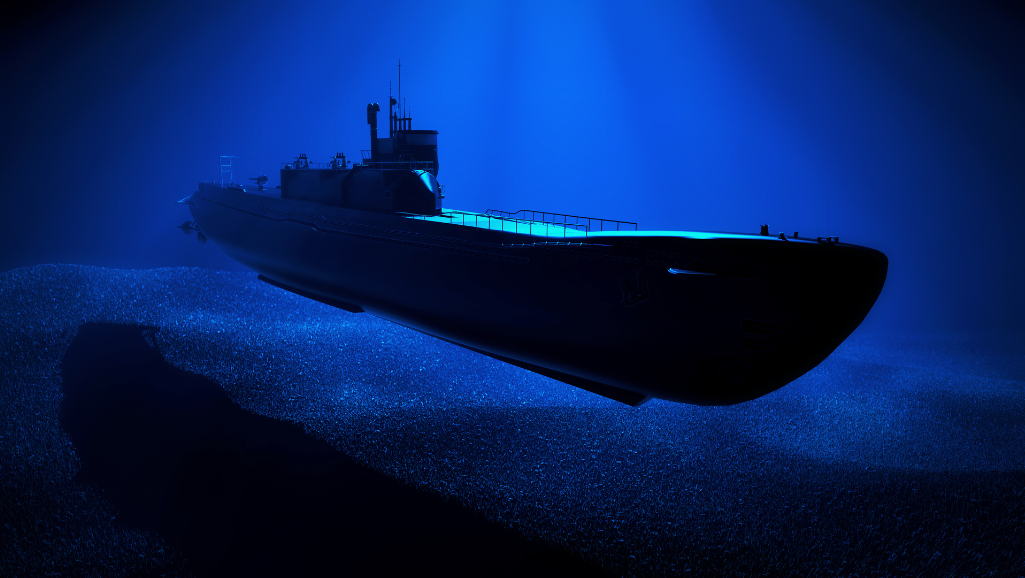If you’ve ever wondered how long a nuclear submarine can stay submerged, this article will provide you with the answers. We’ll dive into the basics of nuclear submarines and how they achieve submersion. You’ll learn about the crucial role of nuclear power in submerged operations and the factors that affect the duration of submerged time. We’ll also explore the record for the longest submerged time and recent advancements in submerged endurance. Get ready to explore the fascinating world of nuclear submarines and their extended submerged missions.
The Basics of Nuclear Submarines
If you want to understand the basics of nuclear submarines, you need to know that they are highly advanced vessels that can remain submerged for extended periods of time. These submarines are powered by nuclear reactors, which provide them with an almost unlimited source of energy. Unlike conventional submarines that rely on diesel engines and batteries, nuclear submarines can operate underwater for months without the need for resurfacing. This extended underwater endurance is made possible by the nuclear reactor, which produces heat that is used to generate steam and power a turbine, which in turn propels the submarine forward.
The ability of nuclear submarines to stay submerged for such long durations is essential for their primary mission: strategic deterrence. By remaining hidden beneath the ocean’s surface, these submarines can silently patrol vast areas, acting as a deterrent to potential adversaries. This stealthy nature allows them to gather intelligence, launch ballistic missiles, or conduct covert operations without being detected.
In addition to their extended underwater endurance, nuclear submarines are equipped with advanced technology and sophisticated systems to ensure their safety and effectiveness. They have advanced sonar systems for detecting and tracking enemy submarines, as well as advanced navigation and communication systems. These submarines also have the capability to launch various types of missiles, torpedoes, and deploy special forces.
How Nuclear Submarines Achieve Submersion
To achieve submersion, a nuclear submarine utilizes its advanced systems and propulsion technology. Here’s a breakdown of how these submarines achieve submersion:
- Ballast Tanks: By flooding the ballast tanks with seawater, the submarine increases its weight, causing it to sink. When the submarine wants to resurface, it expels the water from the ballast tanks, reducing its weight and allowing it to rise.
- Trim Tanks: These tanks are used to control the submarine’s pitch and trim while submerged. By adjusting the amount of water in the trim tanks, the submarine can maintain its desired depth and stability.
- Control Surfaces: Similar to an airplane, a nuclear submarine has control surfaces called diving planes. These planes, located on the bow and stern, help the submarine control its ascent and descent by changing the angle of the hull.
- Propulsion System: Nuclear submarines are equipped with nuclear reactors that power a turbine generator, which produces electricity to drive the submarine’s propulsion system. This system consists of a propulsion motor and a propeller, allowing the submarine to move forward or backward while submerged.
The Role of Nuclear Power in Submerged Operations
Nuclear power plays a vital role in enabling nuclear submarines to remain submerged for extended periods of time, allowing for effective and continuous underwater operations. The key to the prolonged submersion capabilities of these submarines lies in their nuclear propulsion systems. Unlike conventional submarines that rely on diesel engines or batteries, nuclear submarines are equipped with a nuclear reactor that generates heat through nuclear fission. This heat is then used to produce steam, which in turn drives turbines and generates electricity to power the submarine’s propulsion system and other onboard systems.
The use of nuclear power provides several advantages for submerged operations. Firstly, nuclear reactors can generate a significant amount of power, allowing the submarine to operate at high speeds for extended periods without the need for refueling. This provides a significant tactical advantage, as the submarine can swiftly maneuver underwater, evading detection and maintaining a covert presence. Additionally, the virtually limitless power supply provided by nuclear reactors enables the submarine to operate a wide range of advanced systems and equipment, such as sonar, radar, communication systems, and weapons systems, all while remaining submerged.
Furthermore, the continuous power supply from the nuclear reactor ensures that life support systems, such as air conditioning, water purification, and oxygen generation, can be maintained, providing a habitable environment for the crew during extended periods underwater. This capability is essential for the crew’s well-being and overall mission effectiveness.
Factors Affecting the Duration of Submerged Time
The duration of submerged time for a nuclear submarine is influenced by various factors. These factors play a crucial role in determining the length of time a submarine can stay underwater, ensuring its operational effectiveness. Here are some key factors affecting the duration of submerged time:
- Battery capacity: The submarine’s batteries provide power when submerged. The greater the battery capacity, the longer the submarine can stay underwater without surfacing.
- Reactor core: The efficiency and power output of the submarine’s nuclear reactor directly impact its submerged endurance. A more advanced and efficient reactor allows for a longer duration of submerged operations.
- Crew endurance: The physical and mental endurance of the crew members is a critical factor. Fatigue can reduce the effectiveness of the crew and limit the submarine’s submerged time.
- Food and water supply: A sufficient supply of food and water is essential for the crew’s sustenance during prolonged submerged operations. The availability and storage capacity of these resources directly affect the submarine’s endurance.
These factors interact and must be carefully considered when planning and executing submerged missions. By optimizing these factors, submarine operators can maximize the duration of submerged time, enhancing the submarine’s operational capabilities.
The Record for the Longest Submerged Time
One impressive achievement in the realm of submarine operations is the record for the longest submerged time. This record is held by the United States Navy’s USS Pennsylvania, a ballistic missile submarine. In 2016, the USS Pennsylvania set the record by staying submerged for a staggering 140 days. This extraordinary feat showcases the capabilities and endurance of modern nuclear submarines.
The ability to remain submerged for extended periods is a critical aspect of submarine operations. It allows submarines to operate covertly, undetected by potential adversaries. The record set by the USS Pennsylvania demonstrates the advanced technology and engineering that goes into creating these underwater vessels.
To achieve such a prolonged submerged time, nuclear submarines rely on their nuclear power plant, which provides an almost limitless supply of electricity. This allows the submarine to generate the power needed to propel itself underwater and operate its various systems, including life support, communication, and weaponry, without the need for resurfacing.
Additionally, these submarines are equipped with advanced air purification systems, enabling the crew to recycle and purify the air inside the vessel. This eliminates the need to replenish oxygen supplies, further extending the duration of the submarine’s submerged operations.
The record for the longest submerged time is a testament to the advancements in submarine technology and the incredible capabilities of nuclear-powered submarines. It highlights the endurance and versatility of these vessels, making them formidable assets in modern naval warfare.
Recent Technological Advancements in Submerged Endurance
If you’re curious about recent technological advancements in submerged endurance, you’ll be impressed by the strides made in increasing the duration that a nuclear submarine can stay submerged. Thanks to cutting-edge innovations, submarines can now remain underwater for extended periods, enhancing their stealth capabilities and operational effectiveness. Here are some notable advancements in submerged endurance:
- Improved Power Generation: Modern nuclear submarines utilize advanced reactor designs that generate more power while consuming less fuel. This allows for longer periods of submergence without the need to resurface for refueling.
- Enhanced Battery Technology: The development of high-capacity lithium-ion batteries has significantly increased the endurance of submarines. These batteries provide additional power for propulsion and other onboard systems, extending the duration of submerged operations.
- Advanced Air Scrubbing Systems: Submarines now employ highly efficient air scrubbing systems that remove carbon dioxide and other harmful gases from the atmosphere inside the vessel. This enables the crew to remain submerged for longer periods without the need for fresh air.
- Improved Hydrodynamic Design: Submarines now feature sleeker and more hydrodynamic hull designs, reducing drag and improving underwater maneuverability. This allows for smoother and more efficient underwater travel, conserving energy and increasing the duration of submerged operations.
These recent technological advancements have revolutionized submerged endurance, pushing the limits of how long a nuclear submarine can stay submerged. As research and development continue, we can expect further breakthroughs that will further extend the underwater capabilities of these remarkable vessels.
Future Prospects for Extended Submerged Missions
Looking ahead, advancements in technology hold promising prospects for extending the duration of submerged missions for nuclear submarines. With ongoing research and development efforts, there are several key areas that show potential for improving the endurance of these underwater vessels.
One area of focus is the development of advanced propulsion systems. Current nuclear submarines use a combination of nuclear reactors and electric motors to propel themselves underwater. However, future submarines could benefit from more efficient propulsion systems that require less energy and produce less noise. This would not only extend the duration of submerged missions but also enhance stealth capabilities.
Another area of exploration is the improvement of energy storage systems. Current submarines rely on large batteries to store electrical energy for use during submerged operations. However, advancements in battery technology could lead to the development of more compact and higher-capacity batteries, allowing submarines to stay submerged for longer periods without the need to resurface.
Furthermore, advancements in materials science could play a crucial role in the future of extended submerged missions. The development of stronger and lighter materials could reduce the overall weight of the submarine, allowing for increased payload capacity or longer endurance.





